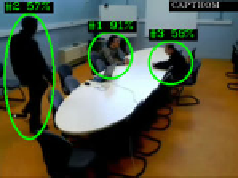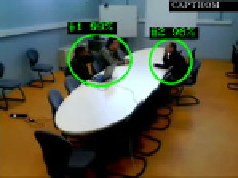Information Technology Reference
In-Depth Information
Fig. 3.
Extract of a scenario example defined by the industrial partners involved in the
CAPTHOM
project
-
Set 1: scenarios involving a normal use of a room. In these scenarios, we need
to detect humans that are static or moving, sitting or standing in oces,
meeting rooms, corridors and dining rooms.
-
Set 2: scenarios of unusual activities (slow or fast falls, abnormal agitation).
-
Set 3: scenarios gathering all false detections stimuli (illumination variation,
moving objects etc).
In the following, Set 4 is defined as the union of these 3 sets. In total, we used
29 images sequences in 10 different places. Images have a resolution of 320 x 240
and have an ”average” quality. Each images sequence lasts from 2 to 10 minutes.
Figures 4 and 5 present results obtained with the
CAPTHOM
algorithm on
videos extracted from our test dataset.
Fig. 4.
Example of results obtained with the
CAPTHOM
method on a video present-
ing partial occlusion
The choice of the evaluation metric parameters, done for this study, corre-
sponds to an expected interpretation compromise which can be encountered in
many real applications. We use a parameter
α
, set at 0.8, to balance the local-
ization and the recognition scores. This high value has been chosen to maintain
an important weight for the penalization of bad localization. It results from a
wide subjective evaluation of interpretation results we conducted, involving re-
searchers of the French community, to better understand when a bad localization




Search WWH ::

Custom Search